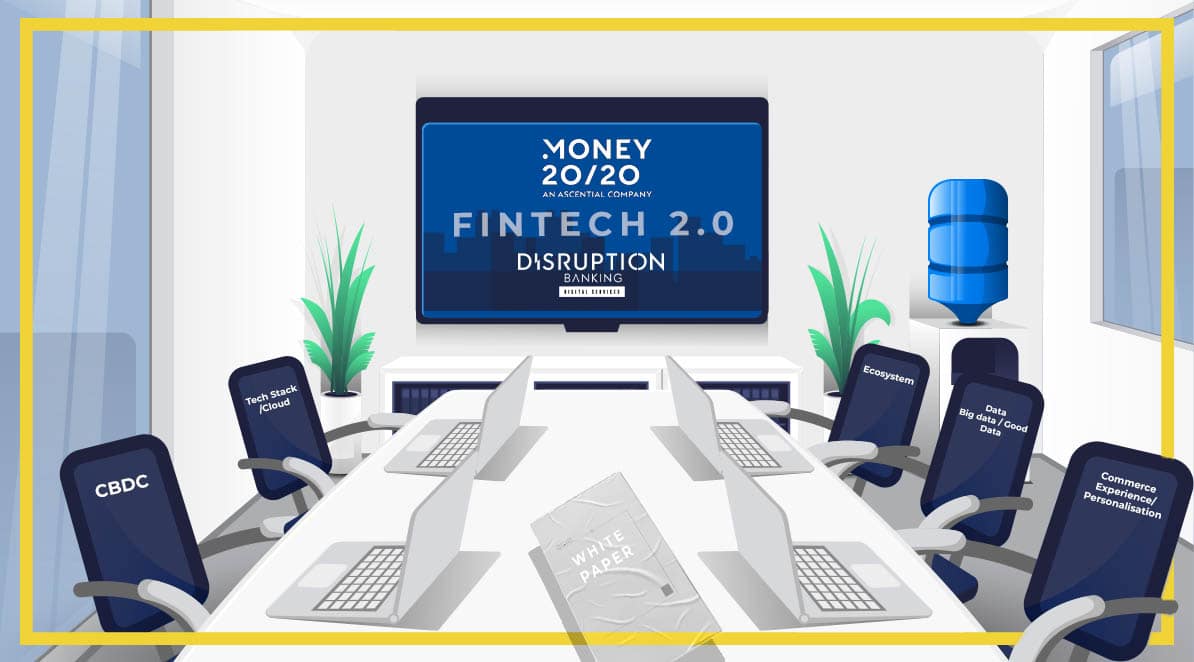Money 20/20 recently released its white paper on ‘The Building Blocks of Fintech 2.0’. Following the immense disruption of the coronavirus pandemic, and all of the innovation that sprung from this, is potentially a period of opportunity and redefinition for the fintech industry. Whilst ‘Fintech 1.0’ focused primarily on digitalising financial services that already existed – taking traditional forms of economic practice online – Money 20/20 expects the new wave of innovation to shift in focus.
As the world begins to reopen following the Covid lockdowns, Money 20/20 believes that ‘stunted economic growth’ will be replaced with ‘aggressive growth’. Roadmaps and growth initiatives will be required to ensure that companies can emerge from the pandemic stronger, although various factors are already in place that will almost certainly facilitate growth. Cloud and 5G technologies will enhance core infrastructure. Large quantities of data will be used strategically for competitive advantage; information will become not merely ‘operational’ but ‘financial’. Fintech services will become hyperpersonalised, as companies adapt and enhance existing infrastructure to fit their products to a wider range of customer experiences.
The Money 20/20 white paper suggests that ‘digitally-native financial services’ will make fintech ‘intrinsically more connected to the economy’, and identifies five ‘building blocks’ which they predict will form the bedrock of the future fintech space.
Assets & Central Bank Digital Currencies (CBDCs)
With more than forty central banks across the world currently piloting CBDC schemes based on new blockchain technology, Money 20/20 sees ‘within three years, five of the world’s ten largest economies [having] CBDCs in the market’. They are likely to progress the work undertaken on previous cryptocurrency projects such as Ethereum. Future CBDCs will be based on blockchain technologies and will take the form of digital tokens that are backed by central banks. In emerging markets, central banks may even begin to use cryptocurrencies such as Bitcoin as a type of reserve currency in order to back their own digital currencies, like we have recently seen in El Salvador.
Many are understandably concerned that CBDCs could raise ‘security and sovereignty concerns’, with expansionist states potentially being able to enforce their digital currency as a global payment system. This would allow them to command a greater degree of economic control. We covered the issue earlier in the year with this piece below:
Want to know more about why China is digitising its' currency? How Covid-19 affected their drive to go cashless? The latest news about Jack Ma? #disruptionbanking has the freshest news: #ModernBankingWars #DigitalYuan #China #JackMa #antgroup https://t.co/XuyqlLDEDg
— #DisruptionBanking (@DisruptionBank) January 21, 2021
That said, CBDCs are almost certainly on their way. Whilst China has already reached the implementation stage of its digital yuan programme, the Bank of England recently commenced research into what Chancellor Rishi Sunak dubbed ‘Britcoin’. It will therefore be up to fintech innovators, working in collaboration with central banks globally, to create this new ‘programmable money’ in a way that minimises, so far as is possible, security concerns and perhaps even helps to ‘increase security, transparency, and control’.
How good can Britcoin be? And will it be Maximum Strength? Rishi Sunak, the Chancellor has showed a big level of appreciation of British fintechs. If the project gets moving, then we may well see a ‘turbo’ version of a CBDC.#Britcoin #CBDChttps://t.co/voHAr1LrW8
— #DisruptionBanking (@DisruptionBank) April 28, 2021
Banking Tech Stacks
Money 20/20 believes that ‘within three years, banking tech stacks will be predominantly cloud-based, with significant elements of core processing being open-source based within five years’. As Hans Brown of BNY Mellon told us, banks and their software engineers should always be looking to improve the services they provide. In any case, operations and technologies are constantly being streamlined for matters of cost and operational efficiency.
"I’m an engineer, so the job is never done. As an engineer, there’s no working system that can’t be made better. People say if it’s not broken, don’t fix it. No, it’s not broken, but let’s make it better." Hans Brown of BNY Mellon shared https://t.co/MfER4fHHvS
— #DisruptionBanking (@DisruptionBank) December 10, 2020
But the Covid-19 pandemic, which necessitated the revamping of ‘core processes and operations’, has speeded this process up. With employees working from home under the various lockdowns, processes were quickly digitised with data being updated in real-time. Cloud-based systems will become of increasing importance as ‘capabilities, efficiencies, and expectations’ also increase. For this reason, banks are already investing considerably higher amounts in tech, as we discussed with Paul Ybarra from Fusion Risk Management. This trend is set to continue.
The Banks are still spending money on Tech. Every day the investment in Tech continues: https://t.co/QZyr8ri8Yy
— #DisruptionBanking (@DisruptionBank) May 20, 2021
Commerce Experiences
Since the dawn of the internet, and particularly with the advent of online shopping in the early part of this millennium, ecommerce sales have increased at an almost exponential rate. Money 20/20 predicts that sales will reach over $6 trillion in 2026, up from just over $3.5 trillion in 2021. This phenomenon will continue to change the shopping experience for millions of people. Of ever-decreasing importance is the set-up of physical stores and previously crucial factors such as ‘product assortment’. Rather, we are moving towards a future where ecommerce companies will have to consider their use of ‘personalised algorithms’ which will work cross-platform and have ‘purchasing, borrowing and payment capabilities embedded inside’.
With consumer permission and regulatory oversight, artificial intelligence and predictive analytics will increasingly be able to make commercially-useful decisions that will influence consumer spending decisions. Whole swathes of data relating to the commerce experience, as well as consumer behaviour and preference trends, will be fed into ever-more complex and developed algorithms that will drive value for fintech companies.
Nanda Kumar shares how @SunTecGroup's Xelerate is a no-code platform, how it’s built to operate and collaborate effectively in multi-application, multi-cloud ecosystems: “We need to keep ourselves agile in the marketplace and be unique in our proposition.”https://t.co/GTbP2Ty58d
— #DisruptionBanking (@DisruptionBank) May 10, 2021
Data
We live in a world where more and more data is available, and in which that data is harvested and deployed for business purposes. With the development of artificial intelligence, we have already seen the power that large-scale data usage can command – whether that is through automated customer service provisions, automated work or data management.
Consumers, however, are becoming increasingly aware of the potential dangers this poses to their privacy. Many are uneasy at the lack of control they believe they have over their personal data and how it is used. For both ideological and practical purposes, Money 20/20 consequently envisages a shift in how data is used by business. This will be driven ‘by consumer desire for control, regulatory desire for safety and business desire for ROI’. Businesses will require greater access to ‘Good data’ – information that is complete, accurate, accessible and acquired through sound governance procedures – for value-creation. As we discussed earlier in the year with Dow Jones, quickly produced and accurate financial data will also be increasingly used by decision-makers for rapid market insights.
“News includes not just information”, Simon argues, “but sentiment”#Nowcasting #DowJones #CentralBanks #AlternativeData #Norges #Covid #ESG #SentimentIndicatorhttps://t.co/bMgQQnm6yp
— #DisruptionBanking (@DisruptionBank) March 18, 2021
Ecosystem
Accelerated by the digitilisation of almost all forms of life throughout the Covid pandemic, the fintech industry is one of rapid growth. Indeed, the industry globally is expected to grow at a compound annual growth rate (CAGR) of 23.6% between 2021 and 2025. Money 20/20 believes the wider ecosystem will expand more dramatically as – with services becoming more comprehensive and deeper-rooted in financial practice – the industry becomes ‘a more critical part of the economy’.
[Analytics] Singapore's #fintech ecosystem and its role in Asean https://t.co/7kJ219yoly
— Pan Pacific Agency (@agency_pan) November 12, 2019
It is possible that fintech products will move from peripheral to central services. In other words, the value of fintech companies will increase in parallel with their societal importance. This will be reflected, it is predicted, by ‘fintech companies being three of the top ten slots of the most valuable companies’ within the next five years.
Money 20/20 events have consistently attracted high-calibre speakers from both the fintech ecosystem and BigTech. Whilst not every speaker is a typical entrepreneur from a Tech hub like Silicon Valley, or an ex-banker from Wall Street, the insights that you can draw at an event like Money 20/20 are frequently of interest to any disruptive business. This white paper is another interesting contribution to the discussion around the future of fintech.
Author: Harry Clynch
#Fintech2.0 #Fintech #Money2020 #Innovation














